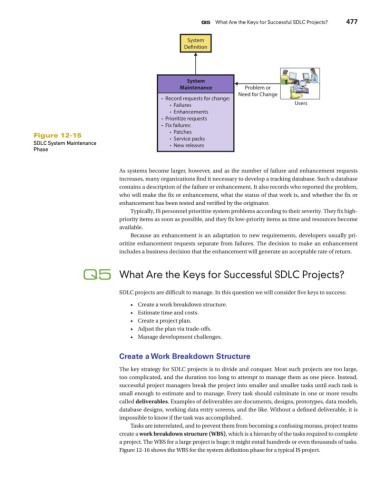Page 509 - Using MIS
P. 509
Q5 What Are the Keys for Successful SDLC Projects? 477
System
Denition
System
Maintenance Problem or
Need for Change
• Record requests for change:
• Failures Users
• Enhancements
• Prioritize requests
• Fix failures:
• Patches
Figure 12-15 • Service packs
SDLC System Maintenance • New releases
Phase
As systems become larger, however, and as the number of failure and enhancement requests
increases, many organizations find it necessary to develop a tracking database. Such a database
contains a description of the failure or enhancement. It also records who reported the problem,
who will make the fix or enhancement, what the status of that work is, and whether the fix or
enhancement has been tested and verified by the originator.
Typically, IS personnel prioritize system problems according to their severity. They fix high-
priority items as soon as possible, and they fix low-priority items as time and resources become
available.
Because an enhancement is an adaptation to new requirements, developers usually pri-
oritize enhancement requests separate from failures. The decision to make an enhancement
includes a business decision that the enhancement will generate an acceptable rate of return.
Q5 What Are the Keys for Successful SDLC Projects?
SDLC projects are difficult to manage. In this question we will consider five keys to success:
• Create a work breakdown structure.
• Estimate time and costs.
• Create a project plan.
• Adjust the plan via trade-offs.
• Manage development challenges.
Create a Work Breakdown Structure
The key strategy for SDLC projects is to divide and conquer. Most such projects are too large,
too complicated, and the duration too long to attempt to manage them as one piece. Instead,
successful project managers break the project into smaller and smaller tasks until each task is
small enough to estimate and to manage. Every task should culminate in one or more results
called deliverables. Examples of deliverables are documents, designs, prototypes, data models,
database designs, working data entry screens, and the like. Without a defined deliverable, it is
impossible to know if the task was accomplished.
Tasks are interrelated, and to prevent them from becoming a confusing morass, project teams
create a work breakdown structure (WBS), which is a hierarchy of the tasks required to complete
a project. The WBS for a large project is huge; it might entail hundreds or even thousands of tasks.
Figure 12-16 shows the WBS for the system definition phase for a typical IS project.

